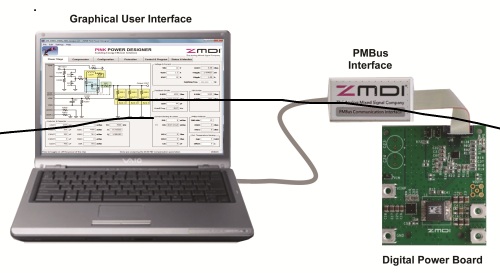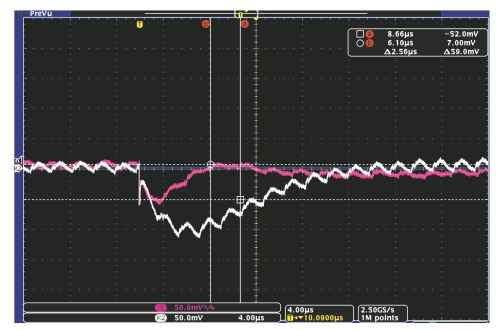By Herman Neufeld
Senior Member of the Technical Staff at ZMDI
Like any new technique that is introduced in the market, digital power control must first prove that it offers important advantages over state-of-the-art analog techniques. In this vein, the first and foremost issue to be addressed is the price, and the secondary considerations are converter size, performance and efficiency. This article covers these issues and also discusses digital power control from a broad standpoint.
What is digital power?
Digital power, as the term implies, is a technique used for converting power via digital control means. Instead of using analog components, such as operational amplifiers and comparators, it uses a digital controller. Both control techniques are designed to ensure that the power stage switches at the right moment in every switching cycle in order to properly regulate the output voltage. Deviations from the correct switching instant lead to deteriorating performance, instabilities, and in extreme cases to malfunction of the load that is being powered. Therefore, performance—not just price—should be something to closely consider. In fact, one of the major differentiators between digital and analog power control is performance.
Cost
For the typical power supply designer, analog technology has been proven to deliver good and efficient power converters. So why change? Why spend more money on a digital controller? What is clearly overlooked here is that not all converter applications require a digital controller. Take, for example, a converter that is required to produce 5 V at 1 A. In this case, analog control is the best choice—a conclusion based purely on price. There are also many analog controllers available on the market. As a rule of thumb, one could state that analog control is the preferred choice for converters with output voltages above 3 V and currents below 10 A. Digital controllers are not meant to compete against these analog controllers, especially when price is important and analog performance is perfectly adequate for the application. However, for a fast-growing market of servers, routers, switches, and embedded controls, the converters that power these applications require a much higher level of performance than analog controllers can offer. Loads such as field-programmable gate arrays (FPGAs), processors, memory banks and similar digital blocks need to interact with the converter feeding them. Analog controllers with a digital interface are also available on the market, but, they are not as flexible as digital controllers when requirements change. ASICs also require development time and cost. With a digital controller, such as ZMDI’s ZSPM1000, the user is able to configure the settings on the controller and issue PMBus commands to change them. The equivalent of an ASIC can also be realized by modifying the firmware in order to meet the customer’s needs. This, however, is done by the IC manufacturer. The cost savings compared to an analog ASIC are achieved because the IC itself does not change.

Fig. 1: Configuration setup for the ZSPM1000 digital controller.
Further reductions in cost can be achieved via a fully automated production process that is possible with a digital controller. The converter can be programmed, tested and calibrated without the need for human intervention.
Design time also needs to be factored into the cost of the converter. When using a digital controller, the converter design does not need to be done by a power supply specialist. It can be done by the very same digital hardware design engineer developing the board. Last-minute changes can be quickly implemented because the requirements are programmed into the digital controller, something that can also be done “on the fly.”
Performance
The kinds of applications addressed by digital controllers are typically more involved than those for analog controllers. Consider, for instance, a fast-occurring 20 A load step at an output voltage of 1 V. At this low voltage, a 200-mV deviation on the output (20%) may be unacceptable for many applications. Resorting to adding more output capacitance on the board in order to minimize output voltage deviations unnecessarily burdens the bill of materials cost while it also slows down the converter’s response. With a digital controller, implementing advanced transient response algorithms, such as ZMDI’s State-Law Control, reduces expenses while improving transient response.
It is also important to know that the LC filter on the output of a DC/DC converter does not exhibit real poles that can be compensated for by the error amplifier’s compensation network. The poles are actually complex, and their position depends on the Q factor of the filter. An unconditionally stable converter can be designed with an analog controller, but at the expense of performance that can easily be obtained from a digital controller. Just imagine having a converter with feedback and feed-forward networks that adapt continuously to your converter’s operating conditions. This is what is achieved with digital power control.
Converter size
The size of a digital converter will typically differ from that of an analog converter depending on the total number of external components needed in order to address the features required by the load.
As far as controller size is concerned, it is important to know that process geometries have become smaller in the past years, allowing digital circuits to benefit from this because they can be scaled down in size much more readily than their analog counterparts. As evidence of this, ZMDI’s high-performance digital PWM controller, the ZSPM1000, comes in a 4 x 4-mm QFN package. Small size also means less silicon area and hence lower cost.
Efficiency
Analog controllers can provide high efficiency over a wide range of output currents by switching between two modes of operation. One is a constant or pseudo-constant frequency mode for continuous conduction of the inductor current, and the other is a pulse-skipping mode for light loads in which the inductor current reaches zero within every switching cycle, and the switching cycle is determined by the droop time of the output capacitors. Digital control does this too, but for output voltages of approximately 1 V and currents in the tens of amperes, additional considerations must be addressed in order to minimize conduction losses and save energy via the various standby and sleep-mode techniques. Once again, a digital controller becomes the ideal choice because it is able to be programmed in various operating modes. In order to reduce conduction losses, a driver MOS or DrMOS power stage is also employed to work alongside the digital controller, for example the ZSPM9060 from ZMDI, which can deliver an average current of up to 60 A. This part has been optimized to provide a very high efficiency.
Another aspect that tends to be overlooked by power supply designers is the relationship between the maximum power delivered by a digitally controlled converter and the digital controller’s active supply current. The digital controller’s operating current is generally higher than its analog counterpart, but for the power levels it controls, this current becomes an insignificant fraction of the total power budget.

Fig. 2: Comparison of the transient response of a digital controller (pink trace) vs. an analog controller (white trace).
PoL modules
Another application that also fits very well for digital control is point-of-load (PoL) modules. Producing DC/DC converter modules requires a high degree of automated production. Variations in module outputs can be easily configured, either via PMBus or via pin-strapping. The module manufacturer can also tailor the module’s characteristics in order to further optimize it to the load.
Future trends in digital power
As the number of digital boards continues to increase and the trend toward more energy-efficient designs continues to dominate, digital power will continue to see a high growth potential in the coming years. Cost savings can be obtained through fast design turnaround times, savings in staff personnel, savings in production costs, and faster time to market.
Advertisement
Learn more about ZMDI





